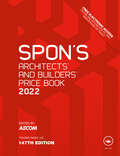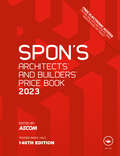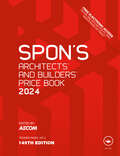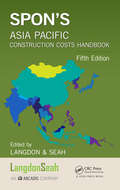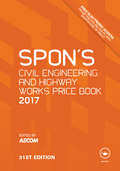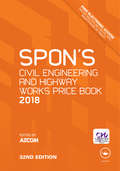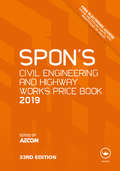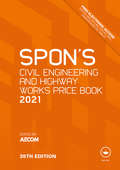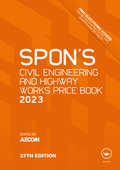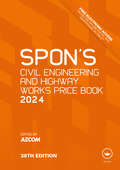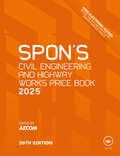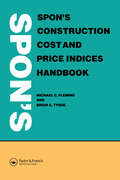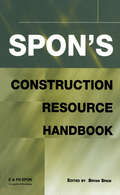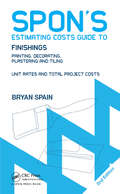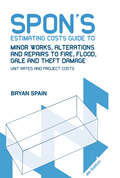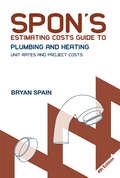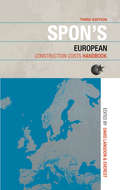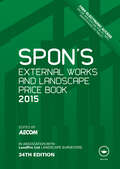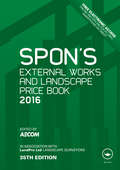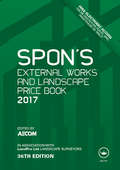- Table View
- List View
Spon's Architects' and Builders' Price Book 2022 (Spon's Price Books)
by AecomA range of factors are all combining to propel input cost inflation. Higher international logistics costs, returning demand from industry workload, and higher global metals prices are some of the ingredients to quicker building cost inflation. Whilst some EU materials exporters to the UK are adjusting to Brexit, other EU exporters ― initially smaller or specialist firms hit proportionally harder ― are now deciding not to supply the UK at all, because the additional red tape involved makes it not commercially viable. If this trend replicates across the whole EU to UK supply chain, visible disruption and higher prices are likely until other sources of supply begin to increase in volume and step in to address these supply issues. Among other exporters continuing to supply the UK, significant price increases are being applied to cover the permanent Brexit non-tariff barriers and additional administrative processes. SPON’S ARCHITECTS’ AND BUILDERS’ PRICE BOOK 2022, compiled by AECOM, still provides the most accurate, detailed and professionally relevant construction price information for the UK. Its unique Tender Index, updated through the year (2015 = 100), gives an ongoing reality check and allows you to adjust for changing market conditions. Although it suits a wide range of project sizes, this is the only price book which sets out a detailed cost base for contracts exceeding £4,000,000 in value. Use the access code inside the front cover of the book to get set up with an ebook of this 2022 edition on the VitalSource® Bookshelf platform, available for access and use until the end of December 2022. As well as an overhaul of prices, 145 new items have been added including: Two new Cost Models for school refurbishment Primary Healthcare Fit-Out Plus, expanded range of cast iron rainwater goods expanded range of matwells expanded range of vinyl floor finishes Ecotherm insulation Along with the standard features you have come to expect from SPON’S ARCHITECTS’ AND BUILDERS’ PRICE BOOK: 20,000 prices for the most frequently specified items, the majority with labour constants and detailed build-ups Hundreds of alternative materials prices for the more unusual items Detailed guidance on wage rates, daywork, cost limits and allowances, property insurance and professional fees, plus useful formulae, design criteria and trade association addresses Updates, free of charge, twice a year – see inside for registration details. Updates are available online at www.pricebooks.co.uk
Spon's Architects' and Builders' Price Book 2023 (Spon's Price Books)
by AecomConstruction cost inflation is at its highest level for decades. Global supply chains have been tested to the max as coronavirus and the war in Ukraine disrupted materials supply and raised energy costs, at a time when UK trade policy was in the midst of significant change. It’s been a perfect inflationary storm and prices of some materials have soared. AECOM’s overall building cost index has reached record highs. Demand is currently holding up but project viability is coming under increasing pressure and headwinds are strengthening. SPON’S ARCHITECTS’ AND BUILDERS’ PRICE BOOK 2023, compiled by AECOM, still provides the most accurate, detailed and professionally relevant construction price information for the UK. Its unique Tender Index, updated through the year (2015 = 100), gives an ongoing reality check and allows you to adjust for changing market conditions. Although it suits a wide range of project sizes, this is the only price book which sets out a detailed cost base for contracts exceeding £4,000,000 in value. Use the access code inside the front cover of the book to get set up with an ebook of this 2023 edition on the VitalSource® Bookshelf platform, available for access and use until the end of December 2023. As well as the most wide-ranging market testing exercise since the war elevated inflationary pressure, the following new items have been added: An update on the exceptional market conditions currently faced A discussion about recent changes to building regulations for non-domestic buildings Along with the standard features you have come to expect from SPON’S ARCHITECTS’ AND BUILDERS’ PRICE BOOK: 20,000 prices for the most frequently specified items, the majority with labour constants and detailed build-ups Hundreds of alternative materials prices for the more unusual items Detailed guidance on wage rates, daywork, cost limits and allowances, property insurance and professional fees, plus useful formulae, design criteria and trade association addresses Updates free of charge – see inside for registration details. Updates are available online at www.pricebooks.co.uk
Spon's Architects' and Builders' Price Book 2024 (Spon's Price Books)
SPON’S ARCHITECTS’ AND BUILDERS’ PRICE BOOK 2024, compiled by AECOM, still provides the most accurate, detailed and professionally relevant construction price information for the UK. Its unique Tender Index, updated through the year (2015 = 100), gives an ongoing reality check and allows you to adjust for changing market conditions. Although it suits a wide range of project sizes, this is the only price book which sets out a detailed cost base for contracts exceeding £4,000,000 in value. Use the access code inside the front cover of the book to get set up with an ebook of this 2024 edition on the VitalSource® Bookshelf platform, available for access and use until the end of December 2024. For the 2024 edition: All prices have been updated via comprehensive supplier engagement combined with AECOM’s market intelligence and a short-term inflationary forecast to ensure you have the most accurate cost data available Activity descriptions and build ups have been updated to reflect changes to standard specifications, Building Regulation changes and emerging practices and changing outputs Along with the standard features you have come to expect from SPON’S ARCHITECTS’ AND BUILDERS’ PRICE BOOK: 20,000 prices for the most frequently specified items, the majority with labour constants and detailed build-ups Hundreds of alternative materials prices for the more unusual items Detailed guidance on wage rates, daywork, cost limits and allowances, property insurance and professional fees, plus useful formulae, design criteria and trade association addresses Updates free of charge – see inside for registration details. Updates are available online at www.pricebooks.co.uk
Spon's Architects' and Builders' Price Book 2025 (Spon's Price Books)
Compiled by AECOM, the 2025 edition has been updated with the latest pricing information to help you manage your projects over the next 12 months through this challenging period of higher inflation and labour shortages.It includes 20,000 prices for the most frequently specified construction items, the majority with labour constants and detailed build-ups. All prices have been updated via comprehensive supplier engagement combined with AECOM’s market intelligence and a short-term inflationary forecast to ensure you have the most accurate cost data available. Activity descriptions and build ups have been updated to reflect changes to standard specifications, Building Regulation changes, emerging practices, and changing outputs. Although it suits a wide range of project sizes, this is the only price book which sets out a detailed cost base for contracts exceeding £4,000,000 in value.All the standard features you have come to expect from SPON'S ARCHITECT'S AND BUILDER'S PRICE BOOK are also included: Hundreds of alternative materials prices for the more unusual items Detailed guidance on wage rates, daywork, cost limits and allowances, property insurance and professional fees, plus useful formulae, design criteria and trade association addresses Included within the inside front cover of every book is a VitalSource® eBook redemption code giving one user access to the content digitally until the end of December 2025.
Spon's Asia Pacific Construction Costs Handbook
by Langdon SeahHighlights the Economies and Construction Industries of the Asia-Pacific Region Spon's Asia-Pacific Construction Costs Handbook: Fifth Edition provides overarching construction cost data for 16 countries: � Brunei� Cambodia� China� Hong Kong� India� Indonesia� Japan� Malaysia� Myanmar� Philippines� Singapore� South Korea� Sri Lanka� Taiwan� Thailan
Spon's Civil Engineering and Highway Works Price Book 2017 (Spon's Price Books)
by AecomTender prices performed strongly again in 2016, with a provisional rate increase of 10.3% versus a year earlier. SPON'S CIVIL ENGINEERING AND HIGHWAY WORKS PRICE BOOK 2017 from AECOM gives costs for both general and civil engineering works and highway works. It provides a full breakdown of labour, plant and material elements, with labour rates updated. It is an essential component of infrastructure estimating maturity, benchmarking and cost intelligence, and gives sound guidance for estimators, contractors and clients. This 31st edition incorporates a comprehensive review throughout: Plant and materials have increased, though not as significantly as labour rates. Some item descriptions have been revised to reflect prices in the global market. And in detail: A revised structure for manhole construction to show detailed build-up. New prices for pre-cast manholes with monolithic precast concrete bases. Updated rail supply and installation rates and a few more added items. Revised piling rates and descriptions. Highway pipe rates adjusted to reflect current market specifications and materials. Revised steel works prices to reflect deflation in this sector. Use the access code inside the front cover of the book to get set up with internet access to this edition until the end of December 2017. We now provide a VitalSource® ebook, giving a versatile and powerful online data viewing package. In a time when it is essential to gain 'competitive advantage' in a congested market, this price book provides instant-access cost information and forms a one-stop reference. … along with the standard features you have come to expect from SPON'S CIVIL ENGINEERING AND HIGHWAY WORKS PRICE BOOK: for budgeting: estimating principles, on-cost advice, method-related charges for resource costings: labour costs, plant costs, material prices for rapid cost information: approximate estimates, dayworks, cost indices for plant and labour allowances: production rates, outputs, man hour constants for detailed pricing: unit costs with full breakdown, or specialist prices, with advice on item coverage, waste allowances and comparative costs for incidental advice: tables and formulae, technical information, professional advice updated, free of charge, two or three times a year – see inside for registration details. Updates are available online at www.pricebooks.co.uk
Spon's Civil Engineering and Highway Works Price Book 2018 (Spon's Price Books)
by AecomSPON'S CIVIL ENGINEERING AND HIGHWAY WORKS PRICE BOOK 2018 from AECOM gives costs for both general and civil engineering works and highway works. It provides a full breakdown of labour, plant and material elements, with labour rates updated. cost guidance is given at a number of levels, varying from the more general functional costs to detailed unit costs, and in conformity with CESMM4 and the Highways Method of Measurement. This 32nd edition incorporates a general update of prices in consultation with leading manufacturers, suppliers and specialist contractors -- especially in line with changes in the labour force and devaluation of the pound: Adjustments to the scope, range and detail of information help the user adjust unit costs with reference to allocated resources and outputs Resource costing in Part 4 is supplemented by the further advice on output factors in Part 10. Rail rates have been heavily revised, as the rail sector is currently overstretched. Man hours methodology has been generally used instead of gang rates, clarifying labour costs and output Use the access code inside the front cover of the book to get set up with a VitalSource® ebook of this 2018 edition. This versatile and powerful online data viewing package is available for use until the end of December 2018. In a time when it is essential to gain 'competitive advantage' in a sometimes turbulent market, this price book provides instant-access cost information and forms a one-stop reference. … along with the standard features you have come to expect from SPON'S CIVIL ENGINEERING AND HIGHWAY WORKS PRICE BOOK: for budgeting: estimating principles, on-cost advice, method-related charges for resource costings: labour costs, plant costs, material prices for rapid cost information: approximate estimates, dayworks, cost indices for plant and labour allowances: production rates, outputs, man hour constants for detailed pricing: unit costs with full breakdown, or specialist prices, with advice on item coverage, waste allowances and comparative costs for incidental advice: tables and formulae, technical information, professional advice updates, free of charge, two or three times a year – see inside for registration details. Updates are available online at www.pricebooks.co.uk
Spon's Civil Engineering and Highway Works Price Book 2019 (Spon's Price Books)
by AecomSPON'S CIVIL ENGINEERING AND HIGHWAY WORKS PRICE BOOK 2019 from AECOM gives costs for both general and civil engineering works and highway works. It provides a full breakdown of labour, plant and material elements, with labour rates updated. cost guidance is given at a number of levels, varying from the more general functional costs to detailed resource costing, and in conformity with CESMM4 and the Highways Method of Measurement. In this 33rd edition: More emphasis has been given to sampling from major projects – of £20-£100m in value with no acute access or ground condition problems and run under NEC contracts. The rates, prices and outputs in the Resources and Unit Cost calculations include allowances for wastage, normal productivity and efficiency. Plus prices from specialists More research with contractors and suppliers allows for a more confident forecast in a volatile market – but outliers have been largely excluded. Prices are based more strongly on global structural steel grades and rates and extrapolated accordingly. Pipe lining is now included, as being more effective and economical than replacement of pipes in maintenance drainage works. Consideration is given to the possible scarcity of skilled labour. Use the access code inside the front cover of the book to get set up with an ebook of this 2019 edition on the VitalSource® Bookshelf platform. This versatile and powerful online data viewing package is available for use until the end of December 2019. … along with the standard features you have come to expect from SPON'S CIVIL ENGINEERING AND HIGHWAY WORKS PRICE BOOK: for budgeting: estimating principles, on-cost advice, method-related charges for resource costings: labour costs, plant costs, material prices for rapid cost information: approximate estimates, dayworks, cost indices for plant and labour allowances: production rates, outputs, man hour constants for detailed pricing: unit costs with full breakdown, or specialist prices, with advice on item coverage, waste allowances and comparative costs for incidental advice: tables and formulae, technical information, professional advice updates, free of charge, two or three times a year – see inside for registration details. Updates are available online at www.pricebooks.co.uk
Spon's Civil Engineering and Highway Works Price Book 2020 (Spon's Price Books)
by AecomSPON'S CIVIL ENGINEERING AND HIGHWAY WORKS PRICE BOOK 2020 from AECOM gives costs for both general and civil engineering works and highway works. It provides a full breakdown of labour, plant and material elements, with labour rates updated. cost guidance is given at a number of levels, varying from the more general functional costs to detailed resource costing, and in conformity with CESMM4 and the Highways Method of Measurement. This 34th edition gives a strong development of prices for excavations and rail, and a general overhaul of prices through the book. Use the access code inside the front cover of the book to get set up with an ebook of this 2020 edition on the VitalSource® Bookshelf platform. This versatile and powerful online data viewing package is available for use until the end of December 2020.
Spon's Civil Engineering and Highway Works Price Book 2021 (Spon's Price Books)
by AecomCaptures real material, plant and labour costs from the UK’s major live rail, civils and highways projects. SPON'S CIVIL ENGINEERING AND HIGHWAY WORKS PRICE BOOK 2021 from AECOM gives a full breakdown of labour, plant and material elements, with labour rates updated. Cost guidance is given at a number of levels, varying from the more general functional costs to detailed resource costing; and in conformity with CESMM4 and the Highways Method of Measurement, and updated to the CIJC wage agreement. This 35th edition gives more items on shafts, tunnelling, drainage and water proofing – covering some brand new materials and methods. Notes have been added to tunnelling, viaducts, D-walls and piling under the output section. The book partially reflects costs and new ways of working resulting from the Covid-19 pandemic. Use the access code inside the front cover of the book to get set up with an ebook of this 2021 edition on the VitalSource® Bookshelf platform, available for access and use until the end of December 2021. … along with the standard features you have come to expect from SPON'S CIVIL ENGINEERING AND HIGHWAY WORKS PRICE BOOK: for budgeting: estimating principles, on-cost advice, method-related charges for resource costings: labour costs, plant costs, material prices for rapid cost information: approximate estimates, dayworks, cost indices for plant and labour allowances: production rates, outputs, man hour constants for detailed pricing: unit costs with full breakdown, or specialist prices, with advice on item coverage, waste allowances and comparative costs for incidental advice: tables and formulae, technical information, professional advice updates, free of charge, twice a year – see inside for registration details. Updates are available online at www.pricebooks.co.uk
Spon's Civil Engineering and Highway Works Price Book 2022 (Spon's Price Books)
by AecomCaptures real material, plant and labour costs from the UK’s major live rail, civils and highways projects. SPON'S CIVIL ENGINEERING AND HIGHWAY WORKS PRICE BOOK 2022 from AECOM gives a full breakdown of labour, plant and material elements, with labour rates updated. Cost guidance is given at a number of levels, varying from the more general functional costs to detailed resource costing; and in conformity with CESMM4 and the Highways Method of Measurement, and updated to the CIJC wage agreement. Use the access code inside the front cover of the book to get set up with an ebook of this 2022 edition on the VitalSource® Bookshelf platform, available for access and use until the end of December 2022. As well as a general update and review of prices, this edition includes extra details on output rates for tunnelling and associated works and additional prices for tunnelling works, cross passages, precast concrete tunnel linings, insitu sprayed concrete lining to tunnel walls and viaducts. … along with the standard features you have come to expect from SPON'S CIVIL ENGINEERING AND HIGHWAY WORKS PRICE BOOK: for budgeting: estimating principles, on-cost advice, method-related charges for resource costings: labour costs, plant costs, material prices for rapid cost information: approximate estimates, dayworks, cost indices for plant and labour allowances: production rates, outputs, man hour constants for detailed pricing: unit costs with full breakdown, or specialist prices, with advice on item coverage, waste allowances and comparative costs for incidental advice: tables and formulae, technical information, professional advice updates, free of charge, twice a year – see inside for registration details. Updates are available online at www.pricebooks.co.uk
Spon's Civil Engineering and Highway Works Price Book 2023: 2003 (Spon's Price Books)
by AecomSPON'S CIVIL ENGINEERING AND HIGHWAY WORKS PRICE BOOK 2023 from AECOM gives a full breakdown of labour, plant and material elements, with labour rates updated. Cost guidance is given at a number of levels, varying from the more general functional costs to detailed resource costing; and in conformity with CESMM4 and the Highways Method of Measurement, and updated to the CIJC wage agreement. Use the access code inside the front cover of the book to get set up with an ebook of this 2023 edition on the VitalSource® Bookshelf platform, available for access and use until the end of December 2023. … along with the standard features you have come to expect from SPON'S CIVIL ENGINEERING AND HIGHWAY WORKS PRICE BOOK: for budgeting: estimating principles, on-cost advice, method-related charges for resource costings: labour costs, plant costs, material prices for rapid cost information: approximate estimates, dayworks, cost indices for plant and labour allowances: production rates, outputs, man hour constants for detailed pricing: unit costs with full breakdown, or specialist prices, with advice on item coverage, waste allowances and comparative costs for incidental advice: tables and formulae, technical information, professional advice updates, free of charge, twice a year – see inside for registration details. Updates are available online at www.pricebooks.co.uk
Spon's Civil Engineering and Highway Works Price Book 2024 (Spon's Price Books)
SPON'S CIVIL ENGINEERING AND HIGHWAY WORKS PRICE BOOK 2024 from AECOM gives a full breakdown of labour, plant and material elements for civil and highway works. Cost guidance is given at a number of levels, varying from the more general functional costs to detailed resource costing; and in conformity with CESMM4 and the Highways Method of Measurement, and updated to the CIJC wage agreement. For the 2024 edition: · All prices have been updated via comprehensive supplier engagement combined with AECOM’s market intelligence and a short-term inflationary forecast to ensure you have the most accurate cost data available This along with the standard features you have come to expect from SPON'S CIVIL ENGINEERING AND HIGHWAY WORKS PRICE BOOK: · for budgeting: estimating principles, on-cost advice, method-related charges · for resource costings: labour costs, plant costs, material prices · for rapid cost information: approximate estimates, dayworks, cost indices · for plant and labour allowances: production rates, outputs, man hour constants · for detailed pricing: unit costs with full breakdown, or specialist prices, with advice on item coverage, waste allowances and comparative costs · for incidental advice: tables and formulae, technical information, professional advice · online updates, free of charge – see inside for registration details. Available online at www.pricebooks.co.uk Use the access code inside the front cover of the book to get set up with an ebook of this 2024 edition on the VitalSource® Bookshelf platform, available for access and use until the end of December 2024.
Spon's Civil Engineering and Highway Works Price Book 2025 (Spon's Price Books)
Compiled by AECOM, the 2025 edition has been updated with the latest pricing information to help you manage your projects over the next 12 months through this challenging period of high inflation and financial uncertainty.It provides a full breakdown of labour, plant and material elements for civil and highway works. Cost guidance is given at a number of levels, varying from the more general functional costs to detailed resource costing; and in conformity with CESMM4 and the Highways Method of Measurement, and updated to the CIJC wage agreement.All prices have been updated via comprehensive supplier engagement combined with AECOM’s market intelligence and a short-term inflationary forecast to ensure you have the most accurate cost data available. Activity descriptions and build ups have been updated to reflect changes to standard specifications, Building Regulation changes, emerging practices, and changing outputs.All the standard features you have come to expect from SPON'S CIVIL ENGINEERING AND HIGHWAY WORKS PRICE BOOK 2025 are also included: Budgeting: estimating principles, on-cost advice, method-related charges Resource costings: labour costs, plant costs, material prices Rapid cost information: approximate estimates, dayworks, cost indices Plant and labour allowances: production rates, outputs, man hour constants Detailed pricing: unit costs with full breakdown, or specialist prices, with advice on item coverage, waste allowances and comparative costs Incidental advice: tables and formulae, technical information, professional advice Included within the inside front cover of every book is a VitalSource® eBook redemption code giving one user access to the content digitally until the end of December 2025.
Spon's Construction Cost and Price Indices Handbook
by M C Fleming B A TysoeThis unique handbook collects together a comprehensive and up-to-date range of indices measuring construction costs and price movements. The authors give guidance on the use of the data making this an essential aid to accurate estimating, as well as examples of how the costs were compiled.
Spon's Construction Resource Handbook (Spon's Price Books)
by Bryan SpainSpon's Construction Resource Handbook is the first book to present critical information about materials, labour and plant constants required for the estimating process under one cover. It covers all areas of the construction industry and will provide all those involved in the preparation of tenders, cost estimates and first-stage estimates with the
Spon's Estimating Cost Guide to Roofing (Spon's Estimating Costs Guides)
by Bryan SpainSpecifically written for contractors and small businesses carrying out small works, Spon's Estimating Cost Guide to Roofing contains accurate information on thousands of rates, each broken down to labour, material overheads and profit.This is the first book to include typical project costs for slating and tiling, sheeting, cladding and ot
Spon's Estimating Costs Guide to Electrical Works: Unit Rates and Project Costs (Spon's Estimating Costs Guides)
by Bryan SpainAll the cost data you need to keep your estimating accurate, competitive and profitable.Do you work on jobs between 50 and 50,000? Then this book is for you.Specially written for contractors and small businesses carrying out small works, Spon's Estimating Cost Guide to Electrical Works provides accurate information on thousands of rates, each bro
Spon's Estimating Costs Guide to Finishings: Painting, Decorating, Plastering and Tiling, Second Edition (Spon's Estimating Costs Guides)
by Bryan SpainSpecially written for contractors and small businesses carrying out small works, Spon's Estimating Cost Guide to Finishings contains accurate information on thousands of rates, each broken down to labour, material overheads and profit.This is the first book to include typical project costs for such a wide range of finishings: painting and wallpaper
Spon's Estimating Costs Guide to Minor Works, Alterations and Repairs to Fire, Flood, Gale and Theft Damage: Unit Rates and Project Costs, Fourth Edition (Spon's Estimating Costs Guides)
by Bryan SpainAll the cost data you need to keep your estimating accurate, competitive and profitable.Do you work on jobs between 50 and 50,000? Then this book is for you.Specially written for contractors, quantity surveyors and clients carrying out small works, this book contains accurate information on thousands of rates each broken down to labour, material
Spon's Estimating Costs Guide to Plumbing and Heating: Unit Rates and Project Costs, Fourth Edition (Spon's Estimating Costs Guides)
by Bryan SpainAll the cost data you need to keep your estimating accurate, competitive and profitable.Do you work on jobs between £50 and £50,000? - Then this book is for you.Specially written for contractors and small businesses carrying out small works, Spon's Estimating Cost Guide to Plumbing and Heating contains accurate information on thousands of rates each broken down to labour, material overheads and profit.The first book to include typical project costs for: rainwater goods installations bathrooms external waste systems central heating systems hot and cold water systems.
Spon's European Construction Costs Handbook (Spon's International Price Books)
by Davis Langdon EverestSpon's European Construction Costs Handbook is the only book of its kind - a unique compilation of cost data on the single most important construction market in the world. This updated edition expands its coverage of countries and once again gives details of select difficult-to-research markets in Eastern Europe as well as Western Europe, North and
Spon's External Works and Landscape Price Book 2015 (Spon's Price Bks.)
by AecomThis year’s book has a strong approximate estimates section, with most measured works items also presented as composite items. Now in its 34th edition, Spon's External Works and Landscape Price Book 2015 offers the only comprehensive source of information for detailed external works and landscape costs. It covers all the items to be found in hard and soft landscape contracts, and forms an indispensable reference book for quantity surveyors, landscape architects, contractors and local authority managers – essential for compiling estimates, specifications, bills of quantities and works schedules – no matter what the size of the project being undertaken. Use the access code inside the front cover of the book to get set up with internet access to this 2015 edition until the end of December 2015. We now provide Spon’s Online, a versatile and powerful online data viewing package, which replaces the estimating software and ebook of recent years. The book now uses a combination of NRM1 and NRM2 as the measurement standards. This edition includes the following new and significantly developed items Further NRM format composites Suspended paving systems Precast walkways New Marshalls paving ranges Reconstituted stone bottle balustrades …and now with a number of landscape cost models.
Spon's External Works and Landscape Price Book 2016 (Spon's Price Bks.)
by AecomNow with two additional external works site cost models – playgrounds and recreation areas, and domestic gardens – added to the three launched last year: housing and house builder, science and office parks, and civic environments and streetscape models. Now in its 35th edition, Spon's External Works and Landscape Price Book 2016 offers the only comprehensive source of information for detailed external works and landscape costs. It covers all the items to be found in hard and soft landscape contracts, and forms an indispensable reference book for quantity surveyors, landscape architects, contractors and local authority managers – essential for compiling estimates, specifications, bills of quantities and works schedules – no matter what the size of the project being undertaken. Use the access code inside the front cover of the book to get set up with internet access to this 2016 edition until the end of December 2016. We now provide SPON’S Online, a versatile and powerful online data viewing package -- online or offline on your PC/Mac, smartphone or tablet. You can browse and search the content across all the price books you own, make notes and highlights and share these notes with other users. Using a combination of NRM1 and NRM2 as the measurement standards, this edition includes the following new and significantly developed items: gatic slot drains restoration brickwork projects sustainable solutions to soil & riverbank erosion, river restoration, & flood management. All the standard features that you expect from SPON'S EXTERNAL WORKS AND LANDSCAPE PRICE BOOK remain: material and measured work prices covering contract items from preliminaries and site clearance and encompassing the core external works activities with full breakdowns into labour, materials and other components detailed guidance on wage rates, landscape consultants’ fee scales an extensive Approximate Estimates section for rapid spot estimating updated, free of charge, two or three times a year – see inside for registration details. Updates are available online at www.pricebooks.co.uk. Other titles in the SPON’S Price Book Series: SPON’S CIVIL ENGINEERING AND HIGHWAY WORKS PRICE BOOK 2016 SPON’S ARCHITECTS’ AND BUILDERS’ PRICE BOOK 2016 SPON’S MECHANICAL AND ELECTRICAL SERVICES PRICE BOOK 2016
Spon's External Works and Landscape Price Book 2017 (Spon's Price Books)
by AecomA general upgrade, with good external works site cost models, strong on composite items and more measured works. Now in its 36th edition, Spon's External Works and Landscape Price Book 2017 offers the only comprehensive source of information for detailed external works and landscape costs. It covers all the items to be found in hard and soft landscape contracts, and forms an indispensable reference book for quantity surveyors, landscape architects, contractors and local authority managers – essential for compiling estimates, specifications, bills of quantities and works schedules – no matter what the size of the project being undertaken. Use the access code inside the front cover of the book to get set up with internet access to this 2017 edition until the end of December 2017. We now provide a VitalSource® ebook, giving a versatile and powerful online data viewing package. This NRM edition includes the following new and significantly developed items: Acoustic fencing Architectural metalwork Block and beam systems Culverts Deep Concrete manholes to 3 m Headwalls Pre-cast steps New retaining walls And green roofs and sportsfields have now been broken down into details, rather than presented as a lump sum. All the standard features that you expect from SPON'S EXTERNAL WORKS AND LANDSCAPE PRICE BOOK remain: material and measured work prices covering contract items from preliminaries and site clearance and encompassing the core external works activities with full breakdowns into labour, materials and other components detailed guidance on wage rates, landscape consultants’ fee scales an extensive Approximate Estimates section for rapid spot estimating updated, free of charge, two or three times a year – see inside for registration details. Updates are available online at www.pricebooks.co.uk.
